#Tribal Education In India
Explore tagged Tumblr posts
Text
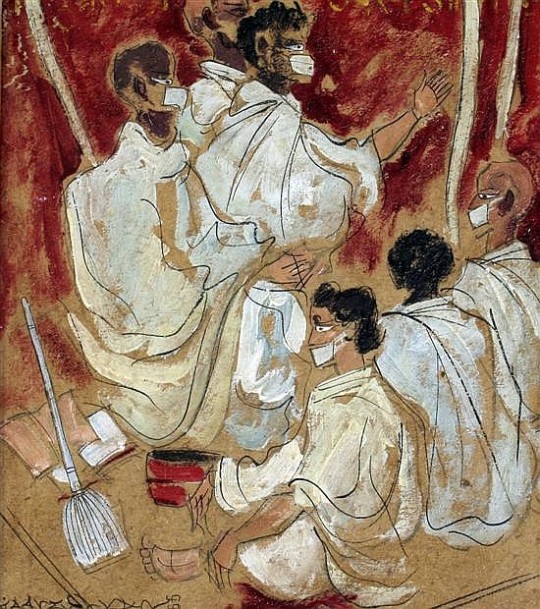


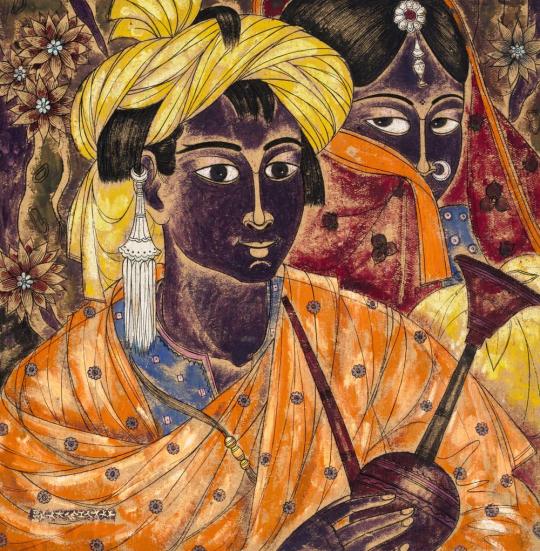
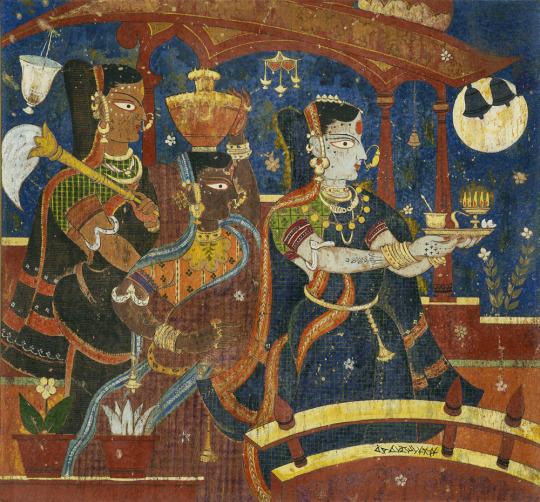

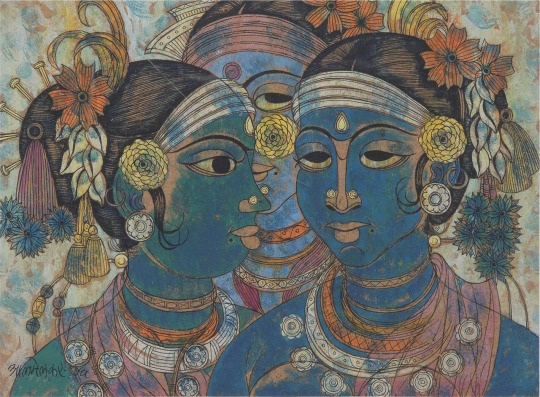

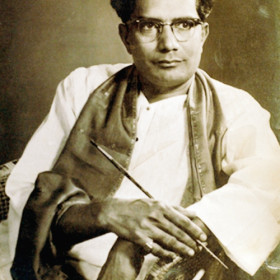

A. A. Almelkar (1920 - 1982, India)
Abdul Rahim Almelkar was born in Sholapur (Maharashtra). He began to paint at a tender age of 7. He completed his schooling at a local school after which he pursued his formal art education at the J.J. School of Art, Bombay. He won several awards at shows organized by the Art Society of India and the Bombay Art Society. Unlike his contemporaries, he branched out into the field of art at an exceptionally early age and evolved in his own pre- eminent style. Almelkar believed his mother’s embroidering during her pregnancy had enriched his creativity from her womb and he believed to inherit the skill of art from that age. He considered Khatri, a painter from Gujarat to be his true teacher. Khatri instilled into the young aspirant a pursuit for perfect draftsmanship. His style of painting was more traditional than his contemporaries with a lot of detailing and elements from miniature art tradition that were at its peak when he was still studying at the art college. His main interests were directed to figurative and naturalistic landscapes. Almelkar often travelled in the jungles of Vidharbha, (a district in Maharashtra) sketching birds, trees and what nature had to offer in sanctuaries and the colourful tribal people inhabiting those localities. He finger painted as well as a drew detailed outlines to his artwork using ink and other mediums. He later joined as a lecturer at the Sir J.J School of Arts in 1968. (AstaGuru - Modern Indian Art)
22 notes
·
View notes
Text
BJP Government is Dedicated to the Education and Development of Youth: Col Rajyavardhan Rathore

The youth are the backbone of any nation, and their education and development are crucial for building a prosperous future. Recognizing this, the BJP government has consistently focused on empowering the younger generation with opportunities, skills, and resources. Col Rajyavardhan Rathore, a prominent leader and Cabinet Minister, has been at the forefront of these efforts, emphasizing the importance of education and holistic development for the youth of India.
Empowering Youth Through Quality Education
1. Focus on Skill-Based Learning
Traditional education is no longer enough. To prepare students for the future, the BJP government has introduced:
Skill development programs tailored to industry demands.
Vocational training centers in rural and urban areas.
2. Enhanced Educational Infrastructure
The government has invested heavily in building and upgrading schools and colleges:
Establishment of smart classrooms equipped with modern technology.
Construction of new universities and research institutes.
Encouraging Innovation and Entrepreneurship
1. Startup Ecosystem for Youth
Under initiatives like Startup India and Atmanirbhar Bharat, young entrepreneurs are being empowered to innovate and build businesses:
Simplified business registration processes.
Financial support through government-backed loans and grants.
2. Digital Literacy Programs
With Digital India, the government ensures that youth in every corner of the country have access to the internet and digital tools. This helps them:
Acquire knowledge and skills online.
Tap into global opportunities.
Sports and Physical Development
1. Building World-Class Sports Facilities
Col Rajyavardhan Rathore, an Olympic medalist, has passionately driven efforts to promote sports:
Establishment of sports academies across the country.
Introduction of scholarship programs for budding athletes.
2. Promoting a Healthy Lifestyle
Campaigns encouraging fitness and well-being, such as Fit India Movement.
Incentives for schools to integrate physical education into their curriculum.
Youth-Centric Policies and Programs
1. National Education Policy (NEP) 2020
A revolutionary framework aimed at:
Making education more holistic and multidisciplinary.
Encouraging critical thinking and creativity.
2. Digital and Financial Inclusion
Providing tablets and laptops to students from economically weaker sections.
Offering financial literacy workshops to make youth financially independent.
Regional Development and Opportunities in Rajasthan
Col Rajyavardhan Rathore has also prioritized the development of Rajasthan, ensuring that youth from the state are not left behind:
Launch of new educational institutions in underserved areas.
Special programs for tribal and rural youth.
Conclusion
The BJP government, led by the vision of Prime Minister Narendra Modi and driven by leaders like Col Rajyavardhan Rathore, is steadfast in its commitment to the youth. By focusing on education, skill development, and entrepreneurship, the government is laying the foundation for a brighter future. The youth of India are not just participants in this journey but the leaders of tomorrow.
4 notes
·
View notes
Text
Innovative CSR Strategies: Collaborating with Marpu Foundation for Sustainable Impact

Introduction
India has emerged as a global leader in driving Sustainable Development Goals (SDG) implementation, with numerous projects addressing critical issues like poverty, health, education, and climate action. At the heart of this movement are organizations like the Marpu Foundation, whose efforts in water conservation, nutrition programs, and community engagement exemplify the power of partnerships in creating meaningful change. This article explores the benefits of collaborating with Marpu Foundation through innovative CSR strategies and highlights some of their impactful initiatives.
1. Water Conservation: A Step Towards Clean Water for All
SDG Focus: Clean Water and Sanitation
Access to clean and sustainable water sources remains a pressing challenge in rural India. The Marpu Foundation has been at the forefront of addressing this issue through initiatives such as:
Borewell Construction: Bringing life-sustaining water to drought-prone areas.
Water Plant Installation: Ensuring access to safe drinking water for underserved communities.
For example, in a remote village in Telangana, Marpu partnered with a CSR sponsor to install a solar-powered water purification system, benefiting over 1,000 households and reducing waterborne diseases significantly.
Why CSR Partnerships Matter
Collaborations with NGOs like Marpu amplify the impact of such initiatives by providing resources, technology, and strategic support. Corporations can not only address SDG 6 (Clean Water and Sanitation) but also create a lasting impact on communities, ensuring the sustainability of these projects.
2. Combating Malnutrition Through Targeted Nutrition Programs
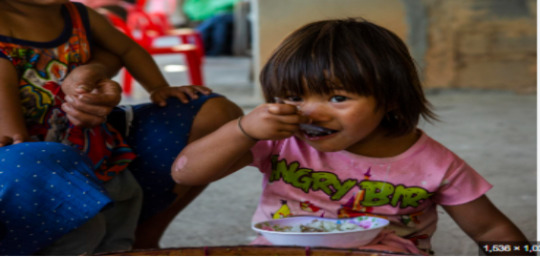
SDG Focus: Zero Hunger & Good Health and Well-being
India’s fight against malnutrition requires a multifaceted approach, and Marpu Foundation plays a vital role by supplementing government programs like Poshan Abhiyaan with grassroots initiatives. Their efforts include:
Conducting nutritional awareness sessions for mothers and children.
Partnering with CSR sponsors to distribute fortified food and essential supplements.
In one notable project, Marpu teamed up with a leading food corporation to establish a community kitchen in a tribal village, providing daily nutritious meals to over 500 children. This initiative not only improved health outcomes but also fostered community participation in tackling malnutrition.
CSR Opportunities
Corporates can scale these programs by funding community kitchens, organizing health camps, and ensuring access to essential resources. These efforts align with SDG 2 (Zero Hunger) and SDG 3 (Good Health and Well-being) while contributing to a healthier and more equitable society.
3. Strengthening Water Accessibility Through Jal Jeevan Mission
SDG Focus: Clean Water and Sanitation
The Jal Jeevan Mission, a government-led initiative, aims to provide safe and adequate drinking water to rural households. Marpu Foundation enhances this mission through community-focused activities, including:
Educating villagers on water conservation and sustainable practices.
Installing rainwater harvesting systems in schools and community centers.
One such collaboration in Andhra Pradesh involved the installation of rainwater harvesting systems in partnership with a corporate CSR sponsor, ensuring year-round water availability for hundreds of families.
The CSR Advantage
By collaborating with NGOs like Marpu, companies can accelerate the progress of initiatives like Jal Jeevan Mission. These partnerships ensure that projects are implemented effectively, reaching the grassroots level and addressing real community needs.
Conclusion
Collaborating with Marpu Foundation provides businesses with an opportunity to implement innovative CSR strategies that address critical social and environmental issues. By supporting impactful projects in water conservation, nutrition, and community engagement, corporations can make a tangible difference while achieving their CSR objectives. Together, we can build a more sustainable and equitable future for all.
2 notes
·
View notes
Text
City Of God
novus ordo hominum
From such a world center of culture and achievement there gradually radiates to all peoples an uplifting and civilizing influence which slowly and certainly transforms the evolutionary races.
Meantime the educated and spiritualized children of the surrounding peoples who have been adopted and trained in the prince’s schools are returning to their native tribal groups and, to the best of their ability, are there establishing new and potent centers of learning and culture which they carry on according to the plan of the prince’s schools.
Australia Tribe - Europa Tribe - India Tribal - Arabia Tribe - North Americas Tribe - South Americas Tribe - Asia Pacific Tribe - Scandinavia Tribe
THE SOVRNTY FOUNDATION AT THE CITY OF GOD
PLANETARY CITIZEN INITIATIVES FOR THE NEW HUMANITY
Mission and Initiatives
To reveal the cosmic realities, mind meanings, spirit values, and infinite vision for all human lives.
To show how all of these divine ministrations, personal or otherwise, are divinely coordinated.
To heal the conceptual poverty associated with so much ideational confusion.
To present enlarged concepts and advanced truth, to expand cosmic consciousness and to enhance spiritual perception.
The City Of God
2 notes
·
View notes
Text
Manipur Violence
As a few of you might be aware, there’s communal violence occurring in the state of Manipur right now. It’s sad that most mainlanders are either completely unaware or do not give a f*ck about it. If you are one of them, here are some news links you can read to educate yourself. I bet if this sort of thing happened in West Bengal, Maharashtra or Uttar Pradesh, it’d become national news… but of course India doesn’t care about its North East. None of my friends here in Odisha, except the North-Easterners know about it :) Meitei, Kuki and Naga lives matter as much as those of mainlanders, so kindly amplify!
#normalweirdoboy#india#today#blog post#north east#news#manipur#meitei#naga#kuki#violence#ethnic clashes
31 notes
·
View notes
Text
The state of tribal children in these traumatic residential schools is worse. The truth is that students in these schools are being stripped off their identities, and even after multiple exposés on deaths and sexual abuse cases in government-run residential tribal schools in Maharashtra, Chhattisgarh, Odisha and Assam, no concrete measures are being taken. Instead, the government plans to set up more residential schools by 2022 under the garb of tribal education and development. Every block with more than 50% ST population and at least 20,000 tribal persons will have an Ekalavya Model Residential School, said the finance minister in his budget speech this February.
India has never evaluated the dangers, purpose and politics of setting up these residential model schools for tribal children. Since the mid 1990s, post liberalisation, many corporations have started operating residential tribal schools as a part of their CSR policies. These companies have a strategic interest in the lands that tribal communities inhabit. Most private-run residential schools in India receive large amounts of funds from companies which wrest control over tribal lands. In fact, residential schools have become a new-age displacement mechanism, under the pretence of an assimilationist education system.
This seems extremely similar to the explicitly genocidal Indian Residential Schools in Canada.
#catgirltxt#what the fuck#disclaimer that i know very little about indigenous groups in india and government policy towards them#but i know enough about residential schools
14 notes
·
View notes
Text
Warli Paintings: Exotic form of simple art

A Picture is a ballad without words. The Warli Art shape is the pictorial dialect used to speak to the tribal people craft of the early tribes of Thane area, Maharashtra.
It portrays the dancing, chasing and development of land with the tribal hovels made in a dark, mustard yellow or the white foundation. Keeping in mind the end goal to educate these structures to the understudies, we embrace a particular showing strategy, so that even non-craftsmen can paint the lovely warli. All these and more can be investigated about the antiquated India.
The word “Warli” originates from “warla” which implies a real estate parcel or a field despite being in such closeness of the biggest city in India, Warli tribesmen are as yet not urban. Warli Art was first found in the mid-seventies. While there are no records of the correct beginnings of this workmanship, its underlying foundations might be followed to as right on time as the tenth century AD. Warli is the distinctive articulation of day by day and get-togethers of the Warli tribe of Maharashtra, utilized by them to enhance the dividers of town houses. This was the main method for transmitting fables to other people who are not familiar with the composed word.
These works of art don’t portray fanciful characters or pictures of divinities, however delineate social life. Pictures of individuals and creatures, alongside scenes from everyday life are made in a free cadenced example. Painted white on mud dividers, they are entirely near pre-notable buckle artistic creations in execution and as a rule delineate scenes of human figures occupied with exercises like chasing, dancing, sowing ,collecting, going out, drawing water from well, drying clothes.
It fundamentally comprises of geometrical examples
1. Circle: speaking to the sun and the moon
2. Triangle: triangle got from mountains and pointed trees
3.Square: showing a consecrated walled area or a land parcel. So the focal rationale in every custom painting is the square
These geometric figures are consolidated to shape lovely examples .Like two summits of triangles are combined to frame a human figure.
Warli canvases on paper have turned out to be exceptionally prevalent and are presently sold all over India. Today, little compositions are done on fabric and paper however they look best on the w alls or as colossal wall paintings that draw out the tremendous and otherworldly universe of the Warlis. For the Warlis, convention is still clung to however in the meantime new thoughts have been permitted to leak in which encourages them to confront new difficulties from the market.
Learn this simple art, find designs & explore the world of warlis at Penkraft through our workshop.
Penkraft conducts classes, course, online courses, live courses, workshops, teachers’ training & online teachers’ training in Handwriting Improvement, Calligraphy, Abacus Maths, Vedic Maths, Phonics and various Craft & Artforms — Madhubani, Mandala, Warli, Gond, Lippan Art, Kalighat, Kalamkari, Pichwai, Cheriyal, Kerala Mural, Pattachitra, Tanjore Painting, One Stroke Painting, Decoupage, Image Transfer, Resin Art, Fluid Art, Alcohol Ink Art, Pop Art, Knife Painting, Scandinavian Art, Water Colors, Coffee Painting, Pencil Shading, Resin Art Advanced etc. at pan-India locations. With our mission to inspire, educate, empower & uplift people through our endeavours, we have trained & operationally supported (and continue to support) 1500+ home-makers to become Penkraft Certified Teachers? in various disciplines.
4 notes
·
View notes
Text
Should the reservation system be removed from India?
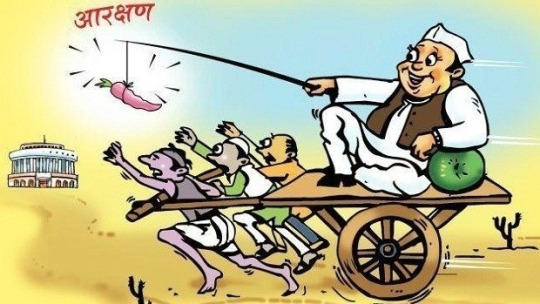
Should the reservation system be removed from India? The reservation system was implemented in India after the partition of 1947 to provide affirmative action for SC, ST, and OBC people, and to ensure adequate representation in government jobs and educational institutions.
However, till today the reservation system is hosting a bitter debate between politicians, social activists, and students. The reservation system should be removed from India. It is a kind of reservation. Everyone has his own point of view about reservations.
As per research conducted by schools in Mumbai most people think that it is helpful and useful for the poor people in India. But I think otherwise. It is not useful for the poor people and it also gives rise to some problems. So, it should be removed from India.
The reservation system was implemented in India by the British empire to uplift the lower classes in India. The system has been a great success and probably has lifted millions out of poverty.
Another survey done by schools in Pune Today, it is time to remove the reservation system from India. In this article, I will explain my argument for its removal. The reservation system has many consequences and both positive and negative.
It is proven to be beneficial for the weaker section of the society but also has many cons, which if considered will deteriorate the social system as a whole.
The reservation system has been a part of our lives since independence and despite that, most of the populations still can't get their education or jobs as per their caste.
In 2016, the government of India issued a draft bill proposing to remove Section 15(1) and (2), which allow for discrimination on the basis of caste and permit the exclusion of some citizens from public goods and services such as schools, hospitals, and public transport.
Reservation is a controversial topic in India. The origin of the reservation in India can be traced back to the historical discrimination meted out to particular castes or tribes for centuries. The first attempt at the reservation was made by the Britishers with an act called the Communal G.O in 1882 which was for the backward classes like Sudras, Harijans, and Tribals.
It was later repealed in 1902 and reintroduced again in 1909 as a Communal award (Lingayat). Then, the reservation was introduced by the Indian National Congress (INC) in 1935 mainly for backward classes like scheduled caste and scheduled tribe in government jobs, education, etc.
Later, the reservation was stopped during the period of British rule but continued after the independence of India through constitutional provision.
Now, reservation has become one of the significant topics to debate in both parliament and public places. Many political parties also built their election manifesto based on this issue only to come into power.
This issue is also used as a political tool to win elections as well as to gain votes by giving false promises.
In a bold move, the Modi government announced last week that it would do away with the reservation system in India. The decision has been welcomed by large sections of society, but there are still some people who think that reservations should be kept.
I'm one of those people. Reservation has done so much for the country, and it should not be removed until a more robust alternative is found to help backward sections of society.
First of all, we should look at how far we've come in the 30 years since the reservation was first introduced. Back then, most Dalits were illiterate and oppressed by upper-caste Hindus.
Today, they have made such great strides in education and employment that they occupy significant positions in several companies and institutions across the country. This is clearly due to the reservation policy.
The reason why I feel reservation should not be abolished is that it will affect these communities adversely. If you take away their quota, they will be unable to compete with richer students from big cities who have had access to better education since childhood.
The only way to ensure equality is to provide them with the same benefits as rich students get — and that's exactly what reservation does.
For example, if a college has a 60% reservation for SC/ST students, then it means that about 20% of the seats are set aside for students who have a poor academic record and have to work extra hard because of their poor family background.
But when you reserve 60% of the seats, you are actually saying that 60% of the seats are reserved only for those students who can’t make it otherwise!
What happens is – that these reserved seats go vacant if nobody applies for them. In that case, they are rolled over to the general category and hence reduce the total number of seats available in the general category!
So even though there was no need to reserve those seats, they have been reserved and now there are fewer seats in the general category! This is how reservation policy is implemented in practice!
3 notes
·
View notes
Text
Achyuta Samanta Honoured with First PIO Excellence Award
With the Pravasi Bharatiya Divas kicking off tomorrow here, the Global Organization of People of Indian Origin (GOPIO) has honoured the Founder of KIIT and KISS Dr. Achyuta Samanta with the first-ever PIO Excellence Award in recognition of his unparalleled contributions to education and tribal empowerment. The award was given away during the ‘PIOs Dialogue with India 2025’ session, organized by KIIT-DU.

Themed “Empowering Global Connections: The Role of PIOs in Emerging India,” the programme brought together dignitaries and leaders from around the world.
Alongside Dr. Samanta, Shanmugan Mookkan, OSD to the Prime Minister of Malaysia, and Professor Ajay Kumar Dubey from JNU were also recognized for their contributions.
A major highlight of the event was the proposal to host an International Cultural Festival for the Indian Diaspora every four years in India. The festival aims to celebrate the rich heritage and contributions of People of Indian Origin (PIO) globally and strengthen their ties with India.
The session also marked the launch of the GOPIO International Chair at KIIT-DU, an initiative dedicated to promoting research and innovation concerning the Indian Diaspora. This chair will facilitate academic studies and document the contributions of PIOs across the globe.
Dr. Samanta, in his speech, expressed his gratitude, saying, “It is an honour for KIIT and KISS to host one of the sessions of PIOs. KIIT has grown from 12 students to over 80,000 today, and KISS has become a revolution in the country. I hope our distinguished guests are pleased to witness this progress.”
Ravendiran Arjunan, Secretary General of GOPIO International, praised KIIT’s remarkable growth: “The KIIT township has grown by leaps and bounds. The Pravasi Bharatiya Divas itself was born out of a request by PIOs to Atal Bihari Vajpayee, and today, the contributions of PIOs in nation-building must be preserved and documented.”
Reflecting on the historical significance of Odisha, Arjunan remarked, “Kalinga was known for its traders and businessmen who travelled across the world. Their contributions are often forgotten, and it is time we preserve their legacy.”
Dr. Ponnusamy Muthayah, President of GOPIO International, traced the origins of Pravasi Bharatiya Divas, highlighting how the conference has brought the Diaspora closer to India.
Vinay Dussoye, Vice President of GOPIO, emphasized the importance of protecting Indian culture and civilization, proposing the International Cultural Festival as a step towards reinforcing global connections. “The process of engaging the Diaspora rests with our younger generation. We must establish ourselves in international business and ensure cultural preservation,” he added.
Former Diplomat and Director General of international Relations, KIIT-DU Debraj Pradhan highlighted the Indian Diaspora’s seller role in India’s growth, while Prof. Saranjit Singh, Vice Chancellor of KIIT-DU, underscored the role of the diaspora in India’s growth. Prof. Debasish Bandopadhyay, Pro Vice-Chancellor, extended the vote of thanks, acknowledging the proposal for the cultural carnival.
0 notes
Text
The Story of a Prosperous Rajasthan: Col Rajyavardhan Rathore’s Vision

Rajasthan, the land of majestic palaces, golden deserts, and vibrant culture, is scripting a new chapter in its history — a story of prosperity and growth. With strong leadership and a vision for the future, Col Rajyavardhan Rathore has been at the forefront of this transformation. His dedication to development, innovation, and inclusivity has laid the foundation for a thriving and self-reliant Rajasthan.
A Legacy of Resilience and Valor
Rajasthan’s journey toward prosperity is rooted in its rich history of courage and resilience. From the valor of Maharana Pratap to the sacrifices of its brave soldiers, the state has always stood tall in the face of challenges. Today, the same indomitable spirit is driving its march toward progress.
The Foundation of Prosperity
Cultural Wealth: Rajasthan’s heritage is not just a source of pride but also a driver of tourism and global recognition.
Natural Resources: With its vast solar potential and mineral reserves, Rajasthan is poised to become a leader in renewable energy and industry.
Col Rajyavardhan Rathore: A Leader Shaping Rajasthan’s Future
Col Rathore’s leadership embodies a unique blend of vision, strategy, and commitment. As an Olympian and Member of Parliament, he understands the importance of discipline and teamwork in achieving goals. His initiatives reflect a comprehensive approach to development, ensuring that every citizen benefits from the state’s growth.
Key Pillars of a Prosperous Rajasthan
1. Infrastructure Development
Rajasthan’s transformation begins with its backbone: infrastructure.
Roadways and Highways: Improved connectivity has opened up opportunities for trade and tourism.
Smart Cities: Urban areas like Jaipur, Udaipur, and Jodhpur are becoming hubs of modern living and economic activity.
Rural Development: Focus on electrification, water supply, and healthcare has improved the quality of life in villages.
2. Economic Empowerment
Col Rathore’s efforts have been instrumental in boosting Rajasthan’s economy.
MSME Growth: Policies aimed at empowering small and medium enterprises have created jobs and strengthened local industries.
Investment Attraction: Events like the Rising Rajasthan Global Investment Summit have brought in significant investments from global players.
3. Renewable Energy Revolution
Solar Power: With projects like the Bhadla Solar Park, Rajasthan is leading India’s renewable energy drive.
Green Jobs: Renewable energy projects are creating employment while ensuring sustainable growth.
4. Tourism as an Economic Driver
Rajasthan’s rich cultural heritage and natural beauty have been harnessed to boost tourism.
Eco-Tourism and Desert Safaris: Promoting sustainable tourism in regions like Jaisalmer and Ranthambore.
Infrastructure for Visitors: Improved facilities have enhanced the state’s global appeal.
5. Education and Skill Development
Quality Education: Initiatives to establish schools and colleges ensure access to quality education.
Skill Training: Programs to equip the youth with skills for emerging industries like IT, manufacturing, and tourism.
A Vision for Inclusive Growth
Col Rathore’s vision of prosperity is inclusive, ensuring that no region or community is left behind.
Women Empowerment: Schemes to provide education, healthcare, and financial independence to women.
Support for Farmers: Modern irrigation techniques, subsidies, and market access are transforming agriculture in the state.
Focus on Tribal and Rural Communities: Targeted programs are uplifting marginalized groups.
Challenges on the Path to Prosperity
Rajasthan’s transformation is not without challenges, including water scarcity, climate change, and rural poverty. However, proactive leadership and innovative solutions have ensured steady progress:
Water Management: Projects like the Eastern Rajasthan Canal Project aim to address water shortages.
Sustainability Initiatives: Emphasis on green energy and eco-friendly policies mitigates environmental concerns.
A Prosperous Future Awaits
The story of Rajasthan’s prosperity is one of courage, vision, and relentless effort. Under the leadership of Col Rajyavardhan Rathore, the state is embracing modernity while staying rooted in its heritage. With continued focus on infrastructure, education, and sustainable development, Rajasthan is not just a symbol of bravery but also a beacon of progress in India.
2 notes
·
View notes
Text
I was speaking with someone from Kerala who had previously complained that she was unable to get good momo in her state as she could in Delhi since momo sellers in Delhi are from the North East or Nepal.They happen to be proficient in Chinese culinary arts. However, I was shocked to hear that she could find nice momo in Kerala, given that the majority of momo sellers are now from the Northeast. I suspected that was a unique incident. However, she informed me that she now sees many North Easterners working in Kerala, ranging from nurses to school teachers. It concerned me because we, as a colonized country, had learned nothing from our colonizers' wicked actions. During the colonial era, Indigenous People, or tribals, were referred to as Savages because they were not suitably civilized for the colonizers. They were not educated in schools like Europeans were, but rather through the transmission of wisdoms on how to coexist with nature, the jungle, and the flora and fauna. They were content without the desire to collect every object they saw or to gain control over those they discovered. "White men's burden" was what they were. The English intervened in the isolated but resourceful regions of tribals in central and eastern India, and their unruly intervention was resisted, but it was quickly controlled with the help of advanced killing tools that the tribals never considered because fighting someone and stealing something that was not theirs was never a priority. The involvement cost them their traditional way of life, culture, and the arrival of aliens that knew nothing but avarice and wanted to exploit whatever they could find. It resulted in poverty and estrangement from the natural resources that they had cultivated for years, forcing the originals to migrate as laborers. India is treating North Eastern tribals in the same way that colonizers treated other tribal regions of India and the world. We didn't learn anything from the past. We establish colonies in our own country.
0 notes
Text

Empowering Tribes Through the PMJUGA Government Initiative
Empowering tribal communities, the Pradhan Mantri Janjatiya Unnat Gram Abhiyan is a transformative step toward development. This initiative enhances infrastructure, education, and healthcare for a better quality of life.
The PMJUGA scheme boosts economic empowerment through skill development and entrepreneurship while ensuring access to essential resources like housing and clean water.
Discover how the PMJUGA initiative is uplifting tribes across India. Learn more about its impactful goals on the India Brand Equity Foundation’s platform.
#PMJUGA#PMJUGAScheme#PMJUGAInitiative#PMJUGAYojana#RuralDevelopment#RuralGrowth#PradhanMantriJanjatiyaUnnatGramAbhiyan
0 notes
Text
Ethics and Ownership of Human Remains
This is an excerpt from a essay on the ethics of private ownership of human remains not for educational, conservation ship, or cultural practices.
The ethical dilemmas surrounding ownership of human remains primarily stem from the lack of informed consent and the exploitation of marginalized communities. Remains were collected from grave robbing or exploited poor families who could not afford to bury their deceased loved ones, usually under the guise of scientific inquiry to further our understanding of the human condition (Potter 2023). One major institution, the National Museum of Natural History, holds over 30,000 human remains, many of which lack clear documentation of their origins (Potter 2023). Poor record keeping and high personnel turnover contribute to the difficulty of addressing the origins of these remains, complicating efforts to ensure ethical stewardship (Licata et al. 2020).
While some of these specimens can be repatriated to living descendants through the Native American Graves Protection and Repatriation Act (NAGPRA), others, regardless of ancestry, will eventually be de-accessioned from institutions and change ownership through various means. For those who do not want skeletal specimens second hand, a thriving online market persists. Websites like Skulls Unlimited and JonsBones will sell to anyone while other platforms like eBay and Instagram host anonymous sales or advertisements of online stores to buy skeletal material, ranging from teaching specimens to “tribal” artifacts (Licata et al. 2020). Skulls Unlimited claims “commitment to ethical sourcing” but does not specify if this applies to their human or animal collections and does not go into further detail on their products’ respective pages. JonsBones admonishes the notion of ethical sourcing as being too vague of a concept, so they invented their own vague concept of “responsible sourcing”. It is somehow better because “our bones are certified bones from the medical trade.” (Ferry, Jon). If this is the same “medical trade” that benefited from 18th and 19th century antiquarianism, grave robbing, and before India’s ban of trading human remains is unclear.
What happens to these remains once in the hands of private ownership is dubious at best. Some people collect “oddities” that range from skeletal remains belonging to humans, non-humans, to the stereotypical specimen in a jar of formaldehyde for their display. This ethically dubious enterprise does not stop at home and office décor. Simply searching the terms “real human bone jewelry” or a similar combination, will lead to online stores selling such items. Curiosities from the 5th Corner, sells a variety of items made from modified human remains, allegedly from remains “over 100 years old”. However, if institutions like the National Museum of Natural History or numerous universities have trouble keeping track of their specimens’ provenance, why should I trust this website? Not to mention remains this old, if they are, should be in an archaeological collection supervised and conserved by competent professionals educated and trained to do so.
There is no shortage of cadaver capers. Southern Nevada Donor Services offers free cremation for families in exchange for donating their deceased loved one under the guise of “advanced medical studies.” However, in 2015 complaints of smells, bloody boxes in dumpsters, and one employee thawing out a frozen human torso with a garden hose (Grow and Shiffman, 2017) reveals the heinous origin of some of these contemporary skeletons.
A recurring theme of apathy stands at the forefront of this issue. These sellers all push a specific narrative to justify their businesses. Curiosities from the 5th Corner responds to the question of if this practice is disrespectful with: “My personal opinion is that you can only disrespect the living.” I find this disingenuous as with the rest of the FAQ this quote is taken from. A similar store, Death Isn’t the End, discusses the origin of their skeletons and other opinions; “I have come across skulls over the years that have been grossly mistreated and damaged, whether it be from accidental drops, occult type ceremony or even malicious intent. These pieces are sometimes very old or some are new and vary in history from museum or private collections to medical schools or colleges and high school science classes and they always made me sad for the destruction of a wonderful thing and for the disrespect of the person it once was.” Somehow creating jewelry from these acquired specimens isn’t a destructive nor disrespectful process, but the most revealing and audacious quote in their about me page is: “I felt that I had found a way to take this neglected and broken skull and give it back respect.”
JonsBones takes this presumptuous attitude farther by disguising their enterprise as educational and equitable because “not everyone has the same access to museums, medical collections, or artifacts that explain and cultivate the science behind bones” and “we actively bridge the gap between the anthropological community and the general public to make osteology more approachable.” The applied anthropological thing to do, in my undergrad opinion, is to indeed give equitable access. However, JonsBones is a store that sells items at price tags equitable only to the wealthy, a demographic that has no shortage of educational access. Certainly, with the profits gained from sales of these items and admission to The Bone Museum, JonsBones could donate to chronically underfunded school districts or fund scholarships for students pursuing biological anthropology, forensics, and fields that utilize human osteology. Unfortunately, this will not happen because it is more profitable to sell and display “responsibly sourced” human remains.
To respond to Curiosities from the 5th Corner’s opinion, this does disrespect the living. It disrespects living descendants, marginalized populations, and continues to feed a market with already dubious tactics and precarious origins as discussed previously. In a majority capitalist world that pushes boundaries in the pursuit of profit with little to no oversight, the commodification of the human body will not stop with one’s bones at the end of a natural lifespan. This fact has already played out historically with the 19th century duo William Burke and William Hare who murdered an estimated sixteen people to sell their bodies to Dr. Robert Knox’s anatomy school (University of Edinburgh).
Licata, Marta et al. “Study, conservation and exhibition of human remains: the need of a bioethical perspective.” Acta bio-medica : Atenei Parmensis vol. 91,4 e2020110. 7 Oct. 2020, doi:10.23750/abm.v91i4.9674
Potter, Lisa. “Ethical Considerations for Human Remains.” https://attheu.utah.edu, University of Utah, 15 May 2023, https://attheu.utah.edu/facultystaff/ethical-considerations-for-human-remains/.
“Burke and Hare.” The University of Edinburgh, https://medicine-vet-medicine.ed.ac.uk/about/history/burke-and-hare. Accessed 27 Nov. 2024.
#human osteology#osteology#ethics in bio anthropology#anthropology#biological anthropology#ethics in anthropology#thoughts#human bones#research#archaeology#physical anthropology#jonsbones#controversial stuff#nagpra#vulture culture#bones
0 notes
Text
HM Amit Shah lands in Bhubaneswar to attend DGP conference
Bhubaneswar: Union Home Minister Amit Shah reached Bhubaneswar Friday to attend the All India DGP/IGP Conference. Chief Minister Mohan Charan Majhi, Union Education Minister Dharmendra Pradhan, Union Tribal Affairs Minister Jual Oram, Deputy Chief Ministers KV Singh Deo and Pravati Parida along with other senior leaders welcomed Shah after his arrival at the Biju Patnaik International Airport,…
0 notes
Text
Jharkhand 2025: Cities, History, Rituals
Jharkhand 2025: Cities, History, Rituals
After the new millennium, the state of Jharkhand was born with several big cities that have played a major role in the economy and culture of the region. Jharkhand 2025
Famous cities are as follows:
Ranchi: The state capital being the center for education and the government, Ranchi is popular for its beautiful waterfalls and center of tribal culture.
Jamshedpur: Alternatively known as Tata Nagar, this city is among the earliest developed industrial estates in India along with the thriving steel and manufacturing industries.
Dhanbad: Often referred to as the “Coal Capital of India”, it enervates extensive territories of coal mining and is an important center of trade this is what makes it an industrialist state.
Bokaro Steel City: Bokaro is slightly different as it is a city predominantly for the people working in the steel industry as IT houses one of the largest steel plants in Asia.
Deoghar: Also, a religious destination, famous for Baidyanath Temple which thousands of worshippers visit each year.
Hazaribagh: This city possesses Hazaribagh National Park, a wildlife and ecological tourism hub, thanks to its natural beauty. The area is coal-bearing as well.
Palamu: This district is known all over the country for its Palamu Tiger Reserve and Betla National Park which are important for wildlife protection and eco-tourism.
Ramgarh: A region of industrial importance, Ramgarh is known for coal mining and has thermal power generation plants installed. It also harbors places of historical and religious importance like the Rajrappa Temple.
Jharkhand is characterized by its varied topography, which includes thick forests, waterfalls, and busy townships with industries. Its beauty in nature complements its development in Industries.
#Jharkhand 2025: Cities#History#Rituals#Jharkhand 2025#Famous cities are as follows#Formations of Jharkhand#Atal Bihari Vajpayee#as the Prime Minister of India#played a pivotal role#Rituals of Jharkhand
0 notes
Text
The Importance of Cultural Sensitivity for IAS Officers

Cultural sensitivity is an essential skill for IAS officers, who serve in a country as diverse and complex as India. Given the multitude of languages, religions, traditions, and social norms across the country, an IAS officer's role requires not only administrative expertise but also a profound understanding of cultural dynamics. As future leaders and change-makers, IAS officers with a deep sense of cultural awareness can more effectively bridge divides, foster community trust, and support inclusive growth.
If you're aspiring to serve in the IAS and make a meaningful impact, developing cultural sensitivity is key. The best IAS academy in Coimbatore can help cultivate this critical trait along with the technical knowledge required for the role.
Why Cultural Sensitivity Matters in IAS
Cultural sensitivity involves recognizing, respecting, and understanding the beliefs and practices of different communities. For IAS officers, who often work in regions far from their own cultural background, this sensitivity is essential for several reasons:
Building Trust with Diverse Communities
An IAS officer’s work often involves interacting with communities that may have unique cultural practices and traditions. Understanding these nuances helps officers connect with people on a personal level, fostering mutual respect and trust. For example, an IAS officer posted in a tribal region must be aware of local traditions and ways of life to build rapport and administer policies effectively. The best IAS academy in Coimbatore emphasizes these skills, ensuring officers are well-prepared for diverse environments.
Effective Policy Implementation
Policies developed at the central or state level often need to be adapted to meet the specific needs of local populations. Officers who are culturally sensitive can customize their approach to ensure that policies resonate with and benefit the communities they are designed to serve. For instance, in education initiatives, understanding the cultural barriers to schooling for girls in certain communities can help an officer address the problem in a way that is meaningful to that group.
Promoting Social Harmony
Cultural sensitivity plays a significant role in maintaining social harmony. IAS officers must often mediate between conflicting interests or oversee areas with intergroup tensions. Officers who respect and understand diverse cultural backgrounds are better equipped to make unbiased decisions, mediate conflicts, and support policies that encourage unity. This ability is crucial in a multicultural country like India, where one small misstep can lead to misunderstandings or escalate tensions.
How Cultural Sensitivity Shapes Effective Leadership in IAS
An IAS officer’s work is both people-centered and policy-driven. Therefore, effective leadership in this role requires a blend of strategic thinking, empathy, and communication skills. Cultural sensitivity enhances all these qualities, enabling officers to:
Understand Public Sentiments: By being attuned to cultural contexts, officers can gauge public sentiment more accurately. This understanding helps in implementing policies in ways that consider public opinion, which is crucial for community acceptance.
Foster Inclusive Growth: Culturally aware officers ensure that their initiatives benefit every section of society, including marginalized communities. This inclusivity is essential for balanced regional development and for uplifting economically and socially disadvantaged groups.
Empower Local Communities: Officers who acknowledge and respect local customs empower communities to take active roles in governance. This empowerment can result in more sustainable development and better citizen participation, as people feel valued and heard in decision-making processes.
The best IAS academy in Coimbatore offers training that includes real-world scenarios and cultural exposure, helping students develop the cultural intelligence needed to lead with empathy and understanding.
Cultivating Cultural Sensitivity During IAS Preparation
IAS preparation is about more than acing exams; it’s also about developing a holistic understanding of the diverse fabric of Indian society. Here are ways in which IAS aspirants can build cultural sensitivity:
Engage with Diverse Perspectives
Reading widely about various cultures, religions, and social structures within India is a foundational step. Books, documentaries, and articles about India's regional diversity can help aspirants gain a broader perspective.
Participate in Cultural Studies and Community Engagement
Many IAS academies encourage students to participate in local cultural programs, seminars, and workshops that focus on community studies. By engaging directly with different communities, students can learn about regional customs, beliefs, and social challenges.
Study Regional Case Studies
The best IAS academy in Coimbatore, for instance, emphasizes the study of regional case studies, allowing students to see how culturally aware policies have had a positive impact in various parts of the country. Case studies on topics like rural development, health initiatives, or education programs provide insight into how understanding cultural dynamics can lead to successful administration.
Learn from Experienced IAS Officers
Interacting with seasoned IAS officers can be incredibly enlightening. Many academies offer guest lectures from current or former IAS officers who share their experiences in culturally diverse settings. Hearing firsthand about the challenges and successes in different regions helps students appreciate the importance of cultural sensitivity.
The Long-Term Impact of Culturally Sensitive IAS Officers
Culturally sensitive IAS officers play a vital role in shaping India’s development. They are able to:
Create Policies that Reflect Ground Realities: Officers who understand cultural contexts can create policies that are practical and sustainable. This ensures that development is not merely theoretical but has a real impact on improving people’s lives.
Enhance Public Trust in Government: When officers respect and acknowledge community customs, they inspire trust and cooperation, which strengthens the relationship between the government and the public.
Support Diversity and Inclusion in Governance: By recognizing the value of India’s cultural diversity, IAS officers promote a more inclusive approach to governance. This inclusivity allows for a richer exchange of ideas and a government that better represents all its people.
Conclusion
Cultural sensitivity is not just an asset but a necessity for IAS officers in India. Their work often places them in positions where understanding and appreciating local traditions can be the difference between successful policy implementation and failure. Aspiring officers should recognize that this skill is as important as technical knowledge and is integral to building trust, promoting harmony, and fostering inclusive growth in society.
The journey to becoming a culturally sensitive and effective IAS officer begins with the right training. For those dedicated to this goal, the best IAS academy in Coimbatore provides comprehensive preparation, equipping students not only to succeed in exams but to excel as leaders and change-makers in their future roles.
0 notes